If you can honestly say you have never ordered a Daiquiri…Well, hats off to you. The sweeter than candy frozen cocktail with artificial fruit flavors is generally topped with Reddi-Whip and served at beachfront and on-board establishments around the world. And, it may have been my go to in earlier years of tropical vacations.
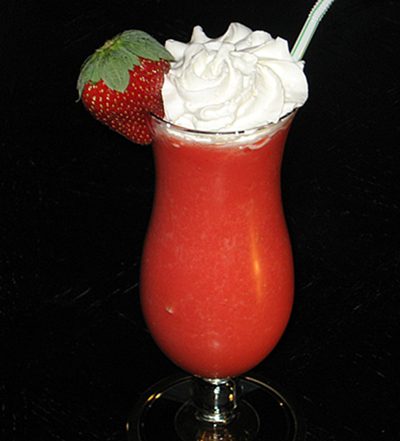
But, this popular cocktail is actually so far from what a traditional Daiquiri is. It has evolved over the past hundred years or so into a shriveled and tourism friendlier version of itself. Although popular with all ages and levels of alcohol consumption, the present day daquiri mocks the sophistication of the classic cocktail of the same name.
Unlike many classic cocktails, the recipes of which have been pondered and evolved, the origins guessed upon, the Daiquiri ACTUALLY has an inception date. A hand written recipe card, dated 1896, provides a timeline for this classic drink conceived in Cuba as a happy accident. An American Engineer working in the Cuba iron mines was entertaining guests one evening and stumbled upon the development of the daquiri with a social faux pas. He ran out of gin.

The engineer, Jennings Stockton Cox, ran to the nearest establishment in search of a bottle to replace his precious gin, the drink du jour of the time. He didn’t want to look unprepared in front of his American guests back at his home, just fourteen miles from Santiago. The only thing he could find is…You guessed it….RUM! Cox, in an effort to mask the strong taste of his aristocratic friends’ sophisticated palates, added lime and sugar to the rum. And thus, a star was born.
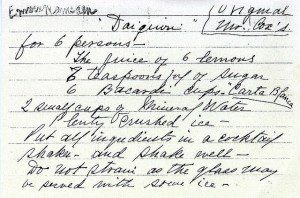
Now, I know it says lemons on the card, which was the American choice for classic cocktails in early days (think Sazerac, Tom Collins, Bees, Knees). But, lemons were not readily available in Cuba and limes were. So, as the drink, named Daiquiri after a nearby port city which consequently was the town where the US first invaded Cuba, remained localized to Cuba until 1909 and steadily grew in popularity there, limes became the norm. It is also important to note that this original recipe was served over ice and made with brown sugar, a commodity more readily available in Cuba than its lighter counterpart.
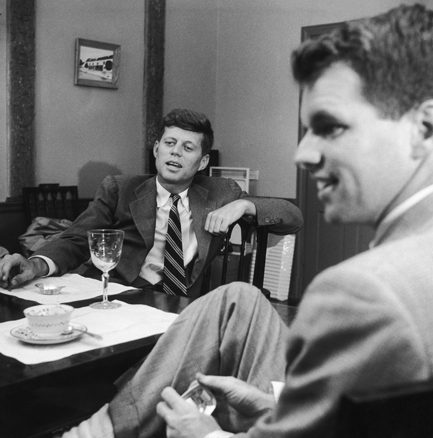
For nearly 15 years, the drink could only be found in Cuba. And then, in 1909, Admiral Lucius W. Johnson, a US Naval Officer, visited Cox and fell in love with his Daiquiris. He brought the recipe home to Washington DC where it steadily grew in popularity served at parties in elite social circles beginning at the DC Army & Navy Officers Club.
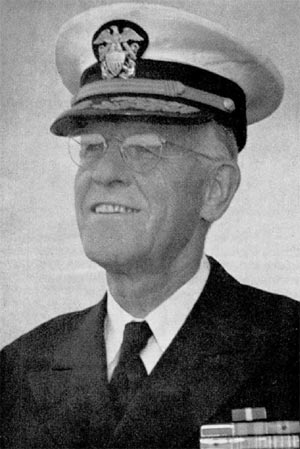
Now, this is a great story, and the recipe is one that Cox may have thought he dreamed up with originality, however, that may not be the case. With rum, lime and sugar readily available in the tropical locales, it is very possible that this drink existed without documentation for decades before. It is also highly likely that this exact, and slightly less refined, mixture had been keeping scurvy at bay for British Naval ships for years before. Now, remember the origin of rum punch from a few weeks back? Five ingredients- Alcohol, Sugar, Water, Citrus, Spice. Well, short of the spice, we are pretty much there with the Daiquiri…and those same Naval ships in Cuba likely had some punch back home in England. So…well, I’ll let you do the math on that one.

Anyway, Cox’s “discovery” of the Daiquiri led to its increasing popularity and evolution, both in Cuba and in the United States. Four years after the classic cocktail hit DC, it was cited by cocktail book author and rum expert, Jeff “Beachbum” Berry, in his Potions of the Caribbean. A bartender at Havana’s Hotel Plaza, Emilio “El Maragato” Gonzalez, is cited as the first to swap the brown sugar for white, and to serve the drink up in a cocktail glass instead of on the rocks. This new evolution diluted the drink a bit less AND let the rum’s flavor profile pop. Thus creating a more sophisticated and booze forward cocktail.
Then, sometime between the 1920’s and 30’s, the owner of the Floridita in Havana evolved the drink further. This step in the evolution of the Daiquiri is what brought us to our present day derivative. As much as I enjoy a sip of a strawberry frozen concoction from time to time, if it ain’t broke, don’t fix it?
Anyway, Constantino “Constante” Ribalaigua Vert, of this little bar in Havana, swapped the lack of ice with freshly shaved ice. And a spin in the electric blender.
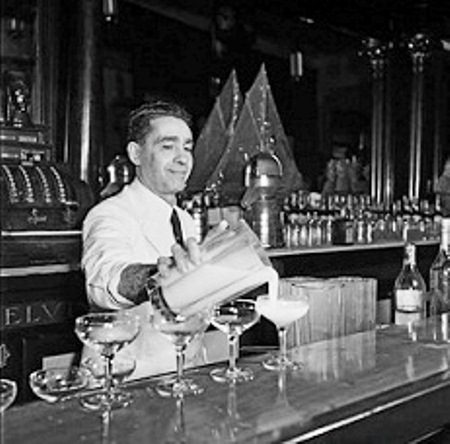
Now, if you’re a literary nut, you may recall that Ernest Hemmingway enjoyed a good Daiquiri. And he did not hide that. The drink is cited in countless letters and novels of his. The man wrote about what and where he drank with a fluidity in his pen. Well, the Floridita was one of his favorite haunts. And is rumored to be the site of his first encounter with his drink of choice in the clubs of Cabana and the dives of Key West.
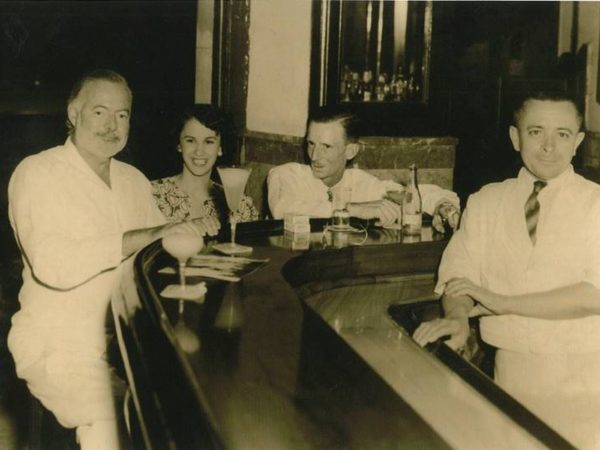
So, I’m not going to bore you with the new school Daiquiri recipe. Throw lime juice, flavored syrup of choice, rum and ice in a blender and top with Reddi-whip. No, we are going to step up our recipe game today. We are going old school today! Back into the era of HEmmingway and JFK and the sophistication of fresh and clean daiquiris served up in a cocktail (martini) glass. Today, we are making cocktails best served in a dimly lit room, warm with good company and the music of Frank Sinatra.
Ingredients for this one are easy:
Rum- For the sake of going old school, I’ll opt out of my traditional lean toward the locally produced Cruzan rum and go back to what Hemingway was likely drinking at the Floridita. At the Floridita, they used Havana Club. Cox’s original recipe called for Bacardi as that was what her readily had on hand. (Disclaimer: I later read that Cox did not go to the liquor store to get the rum, but had it on hand because he used it as rations for the iron miners that worked under him!) Cruzan or any other rum will also work, but make sure it is white and not dark!
Lime Juice- Fresh squeezed is the only way to go on this one! I want to mention here a tip for ordering your favorite frozen drinks…A Daquiri is always going to have some type of lime or citrus element in it. A colada is a similar version of the frozen concoction but swaps out the lime for coconut!
White Sugar- Granulated, run-of-the-mill, household sugar.
Ice- Crushed ice will work best for this to get the little bit of icy film on the top of the glass after the shaken cocktail settles.
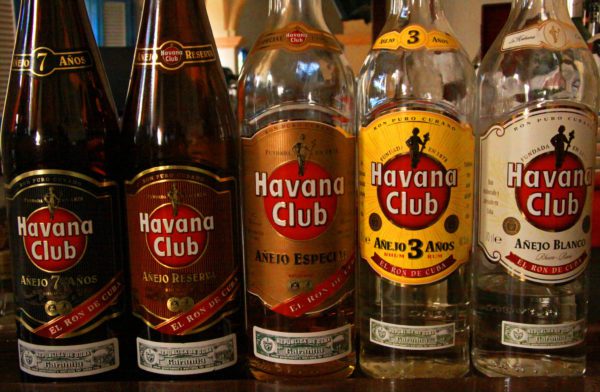
The Classic Daiquiri
2 1/2 Ounces White Rum
The juice of one juicy lime- If the yield is low, add another half or so!
One Heaping Teaspoon of Sugar
First and foremost, fill a martini glass with ice and a bit of water. Now set it aside to chill.
Next, the small end of your cocktail shaker and add your ingredients. Then fill it to three quarters full with ice. Chake the living daylights out of it 🙂
Take your cocktail glass, which should be nice and chilly, and dump the ice and water out. Strain your cocktail into the chilled glass, garnish with a lime wedge and enjoy!

I want to quickly point out that Hemmingway had what you might call a “Daiquiri Problem!” He is quoted as saying “That’s good but I prefer it without sugar and double rum,” upon his first taste of what would come to be his favorite beverage 🙂 The Hemmingway Daiquiri is what eventually evolved from his modifications on the classic cocktail and it is one of my ALL TIME favorite drinks with an addition of Maraschino liquor and fresh squeezed grapefruit juice. Once you have sampled the original daquiri, try this recipe out!


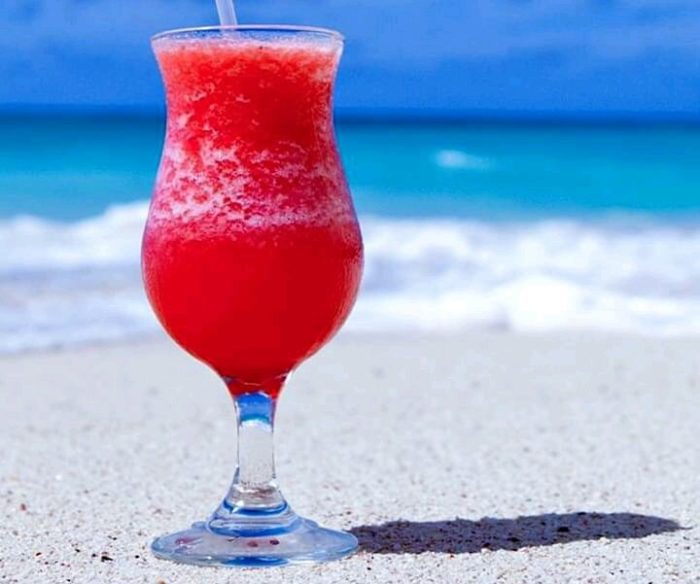
Thanks so much for the history lesson. Love the news letter !!!
Christopher
My wife and I have been visiting St. John for 21 years staying all over the island. We met some wonderful people there and still have contact with them. For ten years Jean, my wife ran in the Ten Tuff Miles and won medals in all but the first and last. (March 2020 ran with pneumonia)
We love your News of St.John
What a great story! Thanks for the research that you had to do. And the addition of pictures is a really nice touch, especially the recipe.
College was, of course, the blender version with frozen strawberries, sugar, and a lot of cheap rum. I remember how sticky the countertop would be the next morning…
But the classic version is the one I will now try.
Again, thank you so much. The history is fascinating.